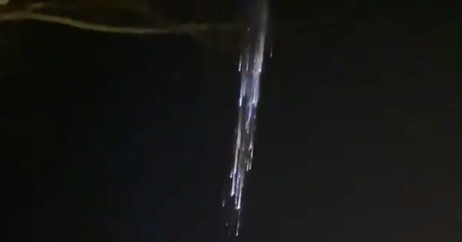SpaceX rocket debris creates a fantastic light show in the Pacific Northwest sky
Source: The Verge added 26th Mar 2021Stargazers in Oregon and Washington were treated to an unexpected show last night: what looked like a meteor shower streaking lazily across the night’s sky that was very likely the remains of a SpaceX Falcon 9 rocket, burning up as it travelled through the atmosphere.
Although SpaceX has not yet claimed responsibility for the spectacle, numerous meteorologists and astronomers ID’ed the lights in the sky as harmless rocket debris. (You can seen plenty of videos of the event in the replies to this Twitter thread.)
“We got a really good show tonight thanks to SpaceX,” James Davenport, an astronomer from the University of Washington, told NBC-affiliate KING5. “This was the top end, what we call the second stage, of a Falcon 9 rocket. It was actually launched about three weeks ago and it did exactly what it was supposed to do: it put satellites in orbit.”
“The only failure it had was it didn’t complete its de-orbit burn, so it didn’t come down when and where we expected it. It’s just been waiting to fall for the last three weeks and we got lucky and it came right over head.”
The Falcon 9 is a partially reusable two-stage rocket. The first stage, housing nine of SpaceX’s Merlin engines, does the initial heavy lifting, getting the rocket off the ground, while the second stage, with just a single Merlin engine, guides it into a parking orbit.
The first stage can be steered back down to Earth, and it’s this section of the rocket you’ve probably seen safely landing (or sometimes not!) on SpaceX’s drone ships. The second stage is usually left to decay in orbit or directed to burn up in the planet’s atmosphere.
This particular launch took place on March 4th, putting another batch of SpaceX’s Starlink satellites into orbit, with the first stage of the rocket safely landing back on Earth.
Jonathan McDowell, an astronomer at the Center for Astrophysics, tweeted a thread about the event, noting that this sort of debris re-entry is not uncommon. “This is the 14th piece of space junk with a mass over one tonne that has reentered since Jan 1st this year,” said McDowell. “In other words, about one a week. Plus lots more smaller bits of course.”
McDowell notes that it can be tricky to predict the timing of these re-entries. The debris breaks up high in the atmosphere, around 40 miles or 60 kilometers above the ground — that’s well above the cruising altitude of commercial flights (around eight miles or 12 kilometers up). But the combination of headwinds in the Earth’s upper atmosphere and the speed of travel (the debris is moving at around 17,000 mph) make it difficult to predict exactly when and where re-entry will take place.
The Falcon 9 second stage from the Mar 4 Starlink launch failed to make a deorbit burn and is now reentering after 22 days in orbit. Its reentry was observed from the Seattle area at about 0400 UTC Mar 26. pic.twitter.com/FQrBrUoBHh
— Jonathan McDowell (@planet4589) March 26, 2021
4) But remember it’s going 17000 mph, so a 5 hour time uncertainty means an 85,000 mile (53000 km) location uncertainty. That’s more that one entire loop around the Earth. That’s why we couldn’t tell in advance that it would be the Seattle area that would see the reentry.
— Jonathan McDowell (@planet4589) March 26, 2021
The National Weather Service (NWS) of Seattle also identified the bright lights as debris from a Falcon 9 second stage. The NWS noted that the speed of such debris re-entry is much slower than that of meteor showers, which move at speeds greater than 45,000 mph.
Such re-entries are generally safe, with all rocket components and material burning up in the atmosphere. As Seattle’s NWS tweeted: “There are NO expected impacts on the ground in our region at this time.”
Right now, it seems like the only lasting effect will be a lot of fantastic footage like the video below:
brands: Advance Area Com Falcon First It LUCKY One Orbit other Planet Space WAS media: 'The Verge' keywords: SpaceX
Related posts
Notice: Undefined variable: all_related in /var/www/vhosts/rondea.com/httpdocs/wp-content/themes/rondea-2-0/single-article.php on line 88
Notice: Undefined variable: all_related in /var/www/vhosts/rondea.com/httpdocs/wp-content/themes/rondea-2-0/single-article.php on line 88
Related Products
Notice: Undefined variable: all_related in /var/www/vhosts/rondea.com/httpdocs/wp-content/themes/rondea-2-0/single-article.php on line 91
Warning: Invalid argument supplied for foreach() in /var/www/vhosts/rondea.com/httpdocs/wp-content/themes/rondea-2-0/single-article.php on line 91
